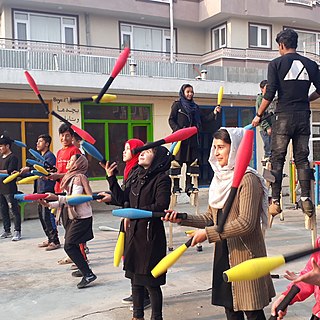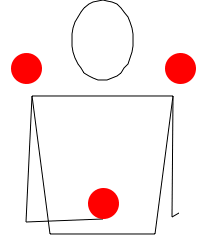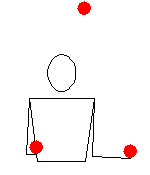Related Research Articles

Juggling is a physical skill, performed by a juggler, involving the manipulation of objects for recreation, entertainment, art or sport. The most recognizable form of juggling is toss juggling. Juggling can be the manipulation of one object or many objects at the same time, most often using one or two hands but also possible with feet. Jugglers often refer to the objects they juggle as props. The most common props are balls, clubs, or rings. Some jugglers use more dramatic objects such as knives, fire torches or chainsaws. The term juggling can also commonly refer to other prop-based manipulation skills, such as diabolo, plate spinning, devil sticks, poi, cigar boxes, contact juggling, hooping, yo-yo, and hat manipulation.

Contact juggling is a form of object manipulation that focuses on the movement of objects such as balls in contact with the body. Although often used in conjunction with "toss juggling", it differs in that it involves the rolling of one or more objects without releasing them into the air.

In toss juggling, a cascade is the simplest juggling pattern achievable with an odd number of props. The simplest juggling pattern is the three-ball cascade, This is therefore the first pattern that most jugglers learn. However, although the shower requires more speed and precision, "some people find that the movement comes naturally to them," and it may be the pattern learned first. "Balls or other props follow a horizontal figure-eight [or hourglass figure] pattern above the hands." In siteswap, each throw in a cascade is notated using the number of balls; thus a three ball cascade is "3".
In the cascade, an object is always thrown from a position near the body's midline in an arc passing underneath the preceding throw and toward the other side of the body, where it is caught and transported again toward the body's midline for the next throw. As a result, the balls travel along the figure-eight path that is characteristic of the cascade.

In toss juggling, Mills' Mess is a popular juggling pattern, typically performed with three balls although the props used and the number of objects can be different. The pattern was invented by and named after Steve Mills. It is a well-known trick among jugglers and learning it is considered somewhat of a milestone, "a mind-boggling pattern of circling balls, crossing and uncrossing hands, and unexpected catches."

In toss juggling, a flash is either a form of numbers juggling where each ball in a juggling pattern is only thrown and caught once or it is a juggling trick where every prop is simultaneously in the air and both hands are empty.

In toss juggling, columns, also known as One-up Two-up, is a juggling trick or pattern where the balls are thrown upwards without any sideways motion, distinguishing it from the fountain. The simplest version involves having three balls, with two going up simultaneously on either side, followed by one going up in the middle. One way to accomplish this is to juggle 2 balls in one hand and one ball in the other, so one hand has to move faster and further than in a regular pattern (cascade), whilst the other remains almost stationary. The hand juggling the center ball can alternate with each repeat to make the pattern symmetric.

Passing is the act of juggling between two or more people. It is most commonly seen as a subset of toss juggling.

Toss juggling is the form of juggling which is most recognisable as 'juggling'. Toss juggling can be used as: a performing art, a sport, a form of exercise, as meditation, a recreational pursuit or hobby.

In toss juggling, the shower is a juggling pattern for 3 or more objects, most commonly balls or bean bags, where objects are thrown in a circular motion. Balls are thrown high from one hand to the other while the other hand passes the ball back horizontally. "In the shower pattern, every ball is thrown in a high arc from the right hand to the left and then quickly passed off with a low throw from the left to the right hand ." The animation depicts a 3-ball version. Siteswap notation for shower patterns is (2n-1)1, where n is the number of objects juggled. The circular motion of the balls is commonly represented in cartoons as the archetypical juggling pattern, somewhat at odds with reality, where the cascade is more common. By constantly reversing the direction, the box pattern can be formed.

Cigar box juggling is the juggling of rectangular props that resemble cigar boxes. Wood block manipulation was thought to have started by Japanese prisoners who were given small wood blocks as head rests for sleeping. Cigar box manipulation was developed as a vaudeville act in the United States between the 1880s and 1920s, and was popularized by W. C. Fields. Originally, performers would take actual boxes that cigars were stored in and nail them shut to create their juggling props. Today, cigar boxes for juggling are typically purpose-built, hollow wooden or plastic blocks with suede or foam rubber padding attached to the sides.
The art of juggling has existed in various cultures throughout history. The beginning is uncertain. The first depictions were found in ancient Egypt, China, Greece, and Rome, as well as medieval and modern societies.
Juggling practice has developed a wide range of patterns and forms which involve different types of manipulation, different props, numbers of props, and numbers of jugglers. The forms of juggling shown here are practiced by amateur, non-performing, hobby jugglers as well as by professional jugglers. The variations of juggling shown here are extensive but not exhaustive as juggling practice develops and creates new patterns on a regular basis. Jugglers do not consciously isolate their juggling into one of the categories shown; instead most jugglers will practice two or more forms, combining the varieties of juggling practice. Some forms are commonly mixed, for example: numbers and patterns with balls; while others are rarely mixed, for example: contact numbers passing. Many Western jugglers also practice other forms of object manipulation, such as diabolo, devil sticks, cigar box manipulation, fire-spinning, contact juggling, hat manipulation, poi, staff-spinning, balancing tricks, bar flair and general circus skills.
Juggling world records comprise the best performances in the fields of endurance and numbers juggling.

Juggling notation is the written depiction of concepts and practices in juggling. Toss juggling patterns have a reputation for being "easier done than said" – while it might be easy to learn a given maneuver and demonstrate it for others, it is often much harder to communicate the idea accurately using speech or plain text. To circumvent this problem, various numeric or diagram-based notation systems have been developed to facilitate communication of patterns or tricks between jugglers, as well the investigation and discovery of new patterns.

iCub is a 1 metre tall open source robotics humanoid robot testbed for research into human cognition and artificial intelligence.

Juggling balls, or simply balls, are a popular prop used by jugglers, either on their own—usually in sets of three or more—or in combination with other props such as clubs or rings. A juggling ball refers to any juggling object that is roughly spherical in nature.

A juggling pattern or juggling trick is a specific manipulation of props during the practice of juggling. "Juggling, like music, combines abstract patterns and mind-body coordination in a pleasing way." Descriptions of patterns and tricks have been most common in toss juggling. A juggling pattern in toss juggling is a sequence of throws and catches using a certain number of props which is repeated continuously. Patterns include simple ones such as the cascade and complex ones such as Mills mess. A juggling trick in toss juggling is a throw or catch which is different from the throws and catches within a pattern. Tricks include simple ones such as a high throw or more difficult ones such a catch on the back of the jugglers neck, as well as the claw, multiplex, and pass. Systems of juggling notation have been created to describe juggling patterns and tricks. One of these is siteswap notation.
Juggling terminology, juggling terms:
References
- 1 2 3 4 Beek, Peter J.; Lewbel, Arthur (1995). "The Science of Juggling" (PDF). Scientific American. 273 (5): 92–97. Bibcode:1995SciAm.273e..92B. doi:10.1038/scientificamerican1195-92. Archived from the original (PDF) on 2016-03-04. ( "The Science of Juggling". Archived from the original on 2016-03-04. Retrieved 2016-02-18.)
- ↑ Schaal, Stefan; Atkeson, Christopher (1993). "Open loop stable control strategies for robot juggling". Proceedings of the IEEE International Conference on Robots and Automation. New York: IEEE Press. 3: 913–18. doi:10.1109/robot.1993.292260. ISBN 978-0-8186-3450-5. S2CID 8935092.
- ↑ Claude Shannon Juggling on YouTube.
- ↑ Mason, Matthew T. (2001). Mechanics of Robotic Manipulation. MIT. p. 233. ISBN 9780262263740.
- ↑ Ackerman, Evan (2012). "Juggling Robot Takes on Two Balls With One Very Fast Hand", Spectrum.IEEE.org & Robotic Two Ball Juggling on YouTube.
- ↑ Jan Peters, Kai Ploeger (2020). "High acceleration reinforcement learning for real-world juggling with binary rewards". arXiv: 2010.13483 [cs.RO].
- ↑ "High Acceleration Reinforcement Learning for Real-World Juggling with Binary Rewards".
- ↑ Bergen, Jennifer (2011). "Robot juggles five balls at a time with ease Archived 2014-08-26 at the Wayback Machine ", Geek.com.
- ↑ "Juggler". Archived from the original on November 14, 2012. Retrieved 2014-08-22.
{{cite web}}: CS1 maint: bot: original URL status unknown (link). - ↑ Robot Juggles 5 Balls on YouTube.
- ↑ Kober, Jens; Glisson, Matthew; Mistry, Michael (2012), "Playing Catch and Juggling with a Humanoid Robot", proceedings at 2012 IEEE-RAS International Conference on Humanoid Robots. .
- ↑ Quick, Darren (2012). "Disney Research robot can juggle, play catch", GizMag.com.
- ↑ Playing Catch and Juggling with a Humanoid Robot on YouTube.
- ↑ "Contact Juggling Robot", MinistryofManipulation.com.

